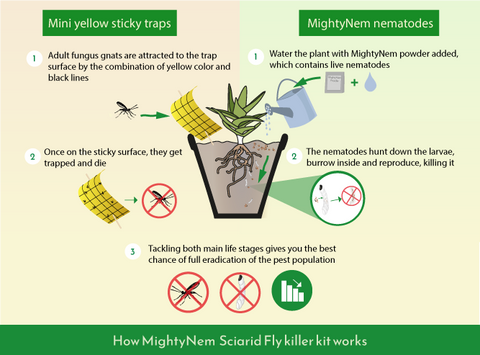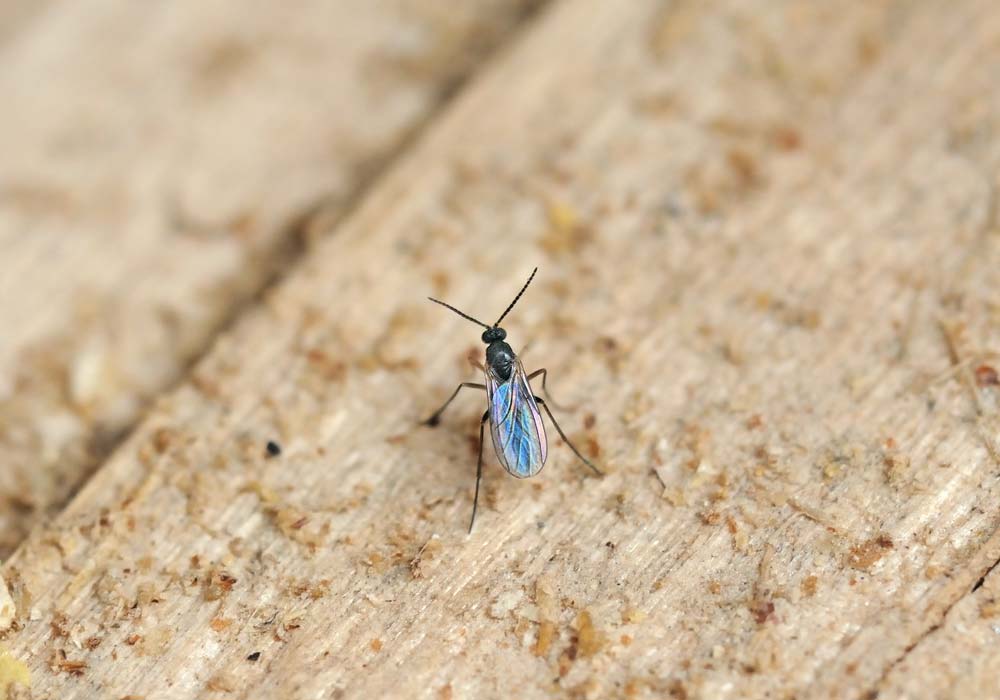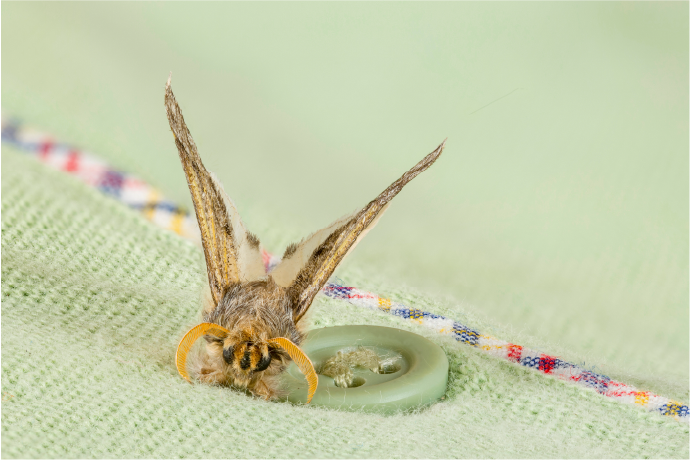Fungus gnats, also known as sciarid flies, affect all types of plants including flowers, fruits and vegetables. They especially love indoor or greenhouse plants in pots and containers due to their moist soil and/or humid conditions, and can be very irritating to have flying around inside.
The larvae can also damage roots, especially seedlings or cuttings. A combination treatment of yellow sticky traps and nematodes to tackle both life stages is usually the best solution.

Identifying fungus gnats
Fungus gnats (or sciarid flies) are the little flying bugs around your plant. They look like small, pale flies with translucent wings that are slow fliers and don’t make an audible buzzing sound.

Close-up of a sciarid fly
There are thousands of different Scaridae species, but they look broadly similar and it’s nearly impossible to see the above detail with the human eye.
They’re commonly mistaken for fruit flies, which are similar in size but very different close up.

Fruit fly close-up
Fungus gnat symptoms
They can be found hovering around your plant, or crawling over them. Indoors, you will notice a gnat slowly flying around the room. They’re attracted to light, as well as heat and scent. For this reason they may seem attracted to you as well.
If you dig through the soil, you may also see the larvae. However, these are hard to see since they are tiny and translucent.

What do fungus gnats eat?
Adult fungus gnats only live on liquids, and don’t actually do any damage to plants. Their presence is just very irritating.
Fungus gnat larvae mostly eat things in the soil like algae, fungi, dead roots and organic matter. However, they can also feed on live roots, damaging your plant. This can cause deformed growth or death.
Seedlings and cuttings are most affected by this and so are a major problem for herbs, greenhouses and nurseries.

Fully-grown plants are much less likely to be damaged, but can be if there's no other food source for the Scaridae.
Where do gnats live?
Fungus gnats are actually attracted to soil, rather than plants, so they can infect all plant types.
They like moist soil so houseplants are ideal, particularly if overwatered or you have a lot of them.

They also like humid conditions, such as greenhouses.
Fungus gnats can affect everything from succulents to tomato plants. They can also infect potting soil bags, which is a very common route of entry into your plants.
They tend to inhabit the top section of the soil.
Do gnats eat plants?
The adult gnats don’t and mostly live off water; the larvae mostly eat organic matter, algae and fungi in the soil, but can also eat roots, especially in seedlings and if there is no other food source.
Gnat lifecycle

Adult fungus gnats live for about 7 days. In this time each female lays a staggering 150 eggs in the soil of your plant. After about 5 days, these eggs hatch into larvae. These larvae are the ones that can cause root damage and live up to 14 days. They then form pupae to transform into the adult fly form, which takes about 5 days.
How long do gnats live?
The whole lifecycle is about 28 days, but the adult fungus gnats live only around 7 days.
Where do fungus gnats come from?
Fungus gnat larvae are normally brought in from infested potting soil, or soil in a new houseplant. They can also be brought in by firewood, since they like the damp bark.

Potting soil is usually not checked for larvae, and even if it is it can easily become infested whilst sitting in your local garden centre.
Fungus gnats can also wander in on their own and lay eggs.
How to get rid of fungus gnats
Killing fungus gnats off for good is difficult since each female lays around 150 eggs in their short lifetime. Fungus gnat numbers grow exponentially, and once set in can be hard to eradicate completely.
Traps
Traps are an easy way to tackle fungus gnats without bringing any chemicals into your home.
Setting traps may be able to eradicate a very small infestation, and will certainly reduce numbers, perhaps to an acceptable level.
Traps are sticky and usually yellow to attract the gnats. They are usually in the form of a yellow sticky card that is simply stuck in your plant using a stick-like stand. Once full of gnats, it needs to be replaced.

Andermatt’s traps use double-sided dry-to-touch glue and have black lines as well as being yellow in colour, to further attract the gnats. Our stands are also plastic-free since they’re made from wood, and the whole thing is fully compostable once finished.

Once on the trap they get caught on the sticky surface and die. Since you can see them, they also work as a visual monitoring system. It’s a cheap, low-maintenance way to prevent the build-up of and monitor infestations in future.
Nematodes
Sciarid fly nematodes are a completely organic, effective way to treat fungus gnats.
Nematodes are microscopic worms that are natural predators of fungus gnats. They come in a powder form which you simply mix with water and add to the soil around your plant using a watering can.

The nematodes can travel through the moist soil and locate the fungus gnat larvae. They then burrow inside and reproduce, killing the larvae and creating more nematodes to hunt down more larvae until none are left. Once the larvae are gone, the nematodes have no prey and naturally die out.
Many people are concerned with bringing something ‘live’ into their home, but there’s nothing to worry about. They can’t interact with humans (or pets) at all. They can only interact with tiny larvae like the sciarid fly. You cannot see them with the human eye and they cannot leave the soil.
We highly recommend using both nematodes and mini yellow sticky traps together. This tackles both main life stages (adult and larvae) to stop the lifecycle and its tracks and prevent more reproduction.

You can get a combined kit with both treatments here

Other treatments
Spray with dish soap
Adding some dish soap to a spray bottle and spraying the top of the soil can help kill off the gnats.
Homemade fungus gnat traps
You can create your own gnat trap simply with a bowl of apple cider vinegar and a few drops of washing-up liquid. The vinegar attracts the gnats, whilst the washing-up liquid makes it hard for them to leave.
The only danger with this is the strong smell may invite other unwanted pests into your home.
Neem oil
Using neem oil to kill gnats is a popular ‘natural’ method in the US, where it is approved. However, neem oil isn’t currently approved for use in the UK.
How to prevent fungus gnats
Although fungus gnats are largely unavoidable, there are some techniques you can try to prevent them:
- Water your plants less. Many a houseplant is watered more than it actually needs. Try watering it less and see how it responds.
- Water from the bottom using a tray, rather than the top. Since the eggs tend to be laid near the top of the soil, this prevents the top section becoming too moist.
- Again to prevent egg laying, try removing the top inch or so of soil and replacing it with gravel or sand.
- Sticky traps last ages so sticking these in your plant pots will tackle an infestation early on
Related Products
SCIARID FLY KILLER KIT

Combination kit of nematodes and sticky traps to tackle both life stages. Free next day delivery.
FUNGUS GNAT MINI YELLOW STICKY TRAPS

10 double-sided mini yellow sticky traps with wooden stands to kill fungus gnats. Free next day delivery.
SCIARID FLY KILLER NEMATODES

Insect-killing nematodes to control fungus gnat larvae. Free next day delivery.


